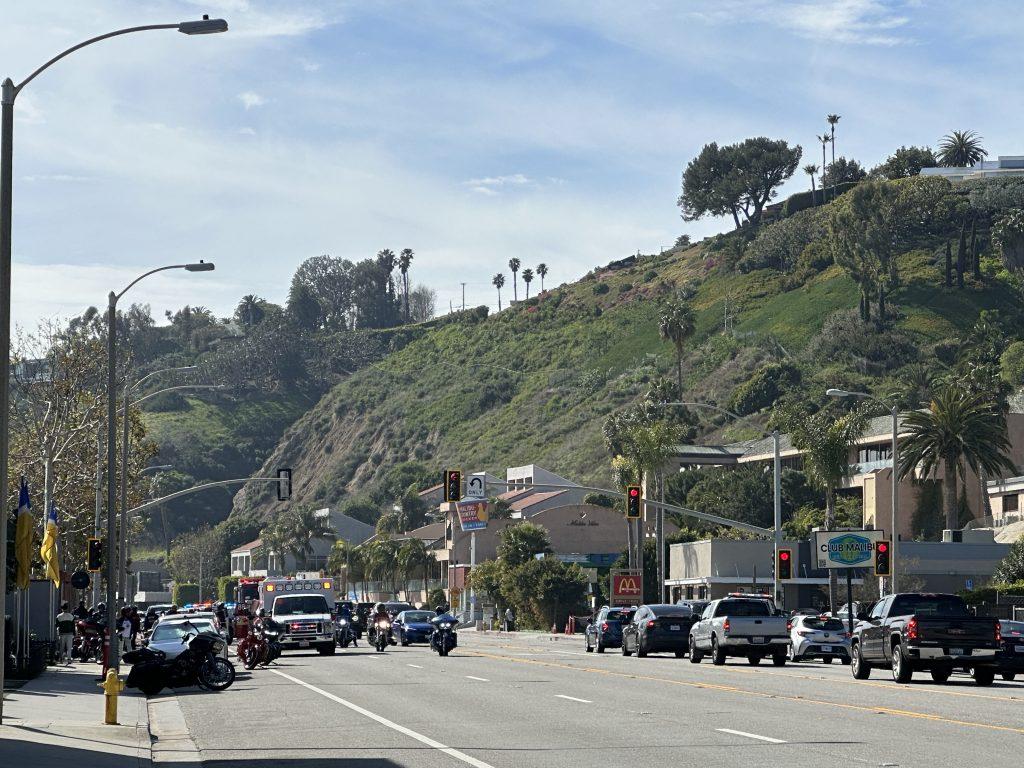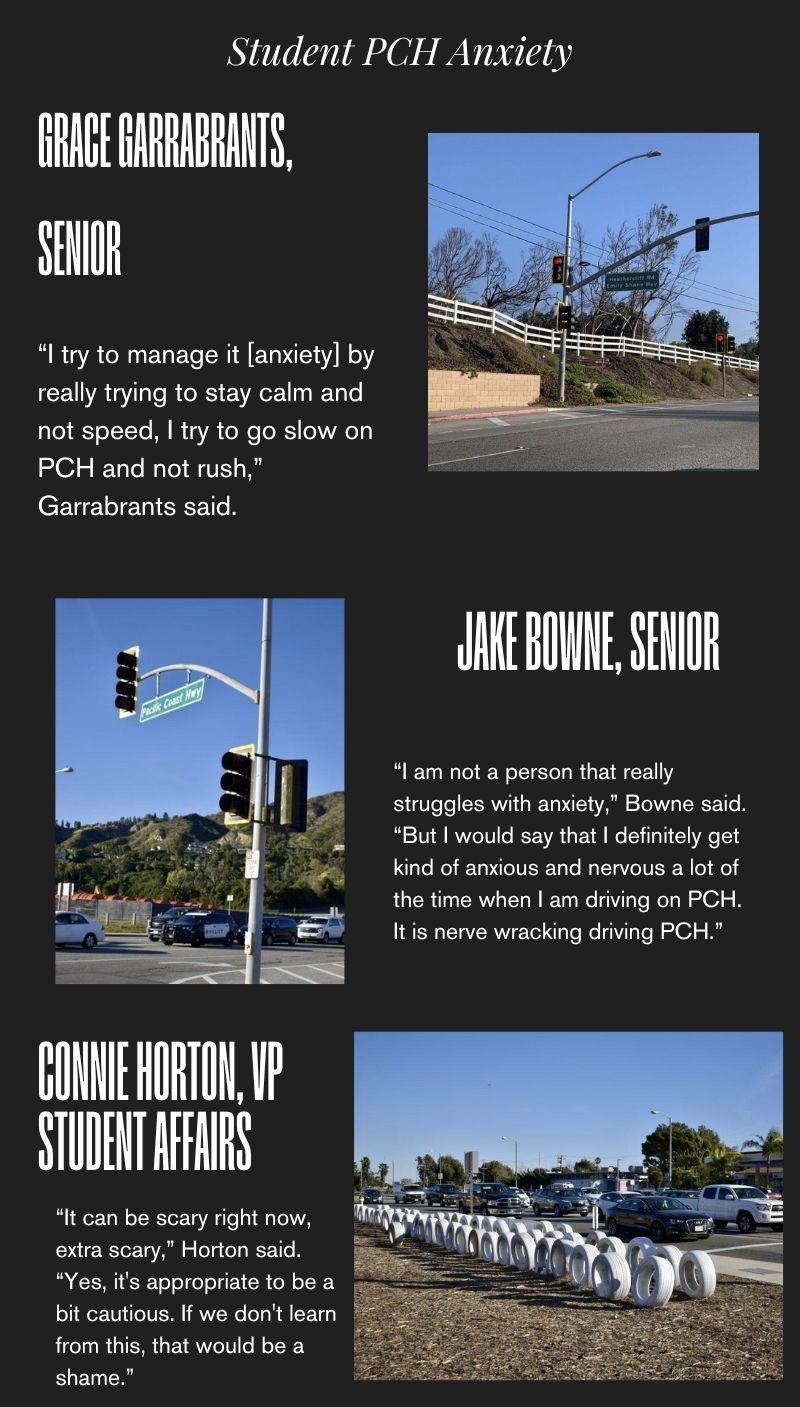
Editor’s note: Running through all 21 miles of Malibu, PCH is a backdrop to daily life and community tragedy. We chose to name this series, “PCH: A Perfect Storm” to encapuslate the beautiful scenery and the deadly risks that face those who use this road. The inspiration for the title of this series came from an October 2023 interview with Michel Shane who lost his daughter, Emily, on PCH in 2010.
Connie Horton, vice president for Student Affairs, said with the dangers on Pacific Coast Highway, she wants students to be aware and cautious without feeling immobilized.
There have been 170 deaths and serious injuries on PCH to drivers, passengers, pedestrians and cyclists between 2011 and 2023, according to the LA Times. Students, such as senior Grace Garrabrants, said they have had anxiety driving on PCH, knowing its dangers for years, and it is especially on everyone’s mind after the Oct. 17 accident that killed four Pepperdine seniors.
“It can be scary right now — extra scary,” Horton said. “Yes, it’s appropriate to be a bit cautious. If we don’t learn from this, that would be a shame.”
Student Concerns
Senior Jake Bowne said he lives right off campus and doesn’t have to drive PCH a lot, but when it comes to errands or going back home to Pasadena, he chooses to take Malibu Canyon.
“I am not a person that really struggles with anxiety,” Bowne said. “But I would say that I definitely get kind of anxious and nervous a lot of the time when I am driving on PCH. It is nerve-wracking driving PCH.”
Bowne said he experiences the most nerves when he sees people jaywalking on PCH or sees reckless speeding from other drivers, weaving in and out of traffic — he also feels one of the biggest threats to PCH is drivers from out of town.
“It is not a straight highway like any other highway in California, and then, coupled with the fact that people do stupid things, it is not a good combination,” Bowne said.
Bowne said he has no way to avoid PCH, and if there was another way to get around, he would take it.
“I kind of just have to stomach it,” Bowne said.
During Bowne’s sophomore year, he comforted a friend who lost someone due to a driving accident. Bowne said he also personally knew three of the four women who died Oct. 17.
“I wish we didn’t have to be reminded like that,” Bowne said.
He said he appreciates the tire memorial on Civic Center way and feels it brings awareness to the dangers of PCH in an effective way. He said his fraternity is his main support system during such times of tragedy.
“You could always get a hug if you needed,” Bowne said.
Garrabrants said she has had driving anxiety her whole life. Growing up on the coast of San Diego, she is no stranger to driving down PCH — and has had multiple small accidents.
“I try to manage it [anxiety] by really trying to stay calm and not speed,” Garrabrants said. “I try to go slow on PCH and not rush.”
Garrabrants lives off campus on PCH and finds herself taking other routes for errands to avoid PCH. She takes her business to Calabasas, avoiding Santa Monica all together.
“I think drivers are more cautious on the canyon because it’s more scary in the fact that you can visibly see the danger,” Garrabrants said.
On PCH, people desire to show off, causing them to drive fast, and drivers can become upset with people driving the speed limit or slower, Garrabrants said.
Garrabrants said her car recently has been hit by multiple falling boulders on PCH. She has also seen a tree in the middle of the road and even popped a tire due to rocks.
When the boulder hit her car, she was nervous and scared, not knowing what to do. She pulled into the next lane, stayed calm and checked for engine lights. After asking her passenger if they felt okay, she kept driving.
Students talk about PCH and its dangers on Fizz, Garrabrants said, and they express frustration with the University when they don’t offer Zoom classes for students in dangerous weather who don’t feel comfortable driving on PCH.
“When PCH is so dangerous, it was honestly not safe for me to go to school,” Garrabrants said. “My car was skidding on the road.”
Garrabrants said she has seen students helping one another and being resilient, watching out for one another when navigating such a tumultuous road.
“Pepperdine has a really good carpool culture,” Garrabrants said. “When my tire popped, all my friends were willing to come and help me when I needed it, and I am willing to always help people, especially if someone is nervous to drive.”

Faculty on Student Fears
At the January NSO, Horton said one of the number one topics on parents’ minds was PCH and what Pepperdine is doing to keep students safe. While Horton informed everyone of the dangers and ways to be safe, she did not want to dissuade students from driving and leaving campus at all, due to the fact that, in this area, the road is unavoidable for basic tasks and travel.
“We live in a beautiful spot, and it comes with certain risks,” Horton said. “Different parts of the country have different risks. In Malibu, there are risks of fires, mudslides and more, and it is good to always be prepared.”
When thinking of one’s PCH anxiety, Horton said it shouldn’t limit the community from experiencing what is beautiful and accessible here, yet it should make the community appropriately cautious and grateful.
Faculty and staff are willing to help students talk through their fears, and the community is very aware of the loss and pain so many have gone through, Horton said. One outcome of the many tragedies that have struck PCH is fighting for reform to make the road safer for all — knowing it is okay to speak about it.
“If I am in one of the zones where I’m just going to the store and I’m not really really feeling nervous, but then you see that [the tire memorial], and it’s like, ‘Okay,’ both in terms of being cautious about driving — and just remembering those precious, precious souls,” Horton said.
___________________
Follow the Graphic on X: @PeppGraphic
Email Beth Gonzales: beth.gonzales@pepperdine.edu
